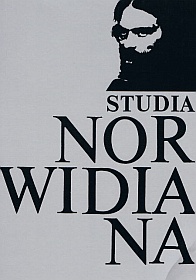Difficult Norwid, Difficult Methodology. How to Study Norwid? (transl. by Jan Kłos)
Abstract
Cyprian Norwid's literary biography, his literary and artistic endeavour show a boundary situation in the humanities and challenge the existing technique of study and methods of interpretation. This boundary situation was composed by the following elements: a) Norwid's peripheral in his own epoch that resulted in a lack of acceptance and communication, b) poverty and the struggle for survival, c) few publications during his lifetime, dispersal and loss of a part of his manuscripts, d) isolation during his sojourn abroad in France, Italy, and the United States, e) his hermetic language and thought, f) universalistic aesthetic and philosophical attitude that was in conflict with the positivistic and utilitaritarian tendencies of the epoch, g) an unusually broad and heterogenic group of sourcews, h) discontinuity and multifarious reception, i) combination of innovation and traditionalism
The author confronts the writer's boundary situation with the current research standards and methodologies. In part I, he considers the influence of the historical, hermeneutic, and cognitive distance on the modes of research interpretation and presentation of Norwid; he discusses the methods and effects of taming and consuming his historical novelty, and puts together the real and historical presence in the writer's epoch with postmortem symbolical presence
Part II analyses methods of the reconstruction of the “true Norwid” and stresses the impact of the writer's image, promoted as “true,” on the time, circumstances, and manner of the reconstruction itself. This part claims that if we make one of many Norwid's images “always and everywhere true,” then we have aspirations to cognitive exclusiveness, make it uniform and appropriate the poet's image. As a result, his interpretation is made rigid
Part III discusses the tension between the poet's universalism – e.g. his declaration of eternal and universally valid truths – the historical genesis and the shape of this kind of messages typical of the epoch. The ahistorical relationship to the poet's declarations gives rise to a phenomenon that is called interpretation of “Norwid by way of Norwid” in Norwidology, a fact that should be deemed vicious circle from the methodological point of view
Part IV Mythologies and Methodologies evaluates the usefulness of contemporary standard research methods in solving difficulties that compose the knowledge of Norwid. This part indicates the incommensurable character of cognitive and methodological presuppositions, which Norwid himself used in his interpretation and description of the world together with the presuppositions that are used in contemporary theories of knowledge and methodologies
The final conclusion of the paper reads that the difficulties in studying Norwid make us aware that the author of Silence is not for the contemporary methodologies merely a passive “object” with which, as the “hermeneutics of violence” declares, one can make everything whatever one wills, but it is a challenge for them that unveils both their strong and weak points. He is therefore their critical partner, and at times also a constructive alternative
Copyright (c) 2010 Studia Norwidiana

This work is licensed under a Creative Commons Attribution-NonCommercial-NoDerivatives 4.0 International License.





